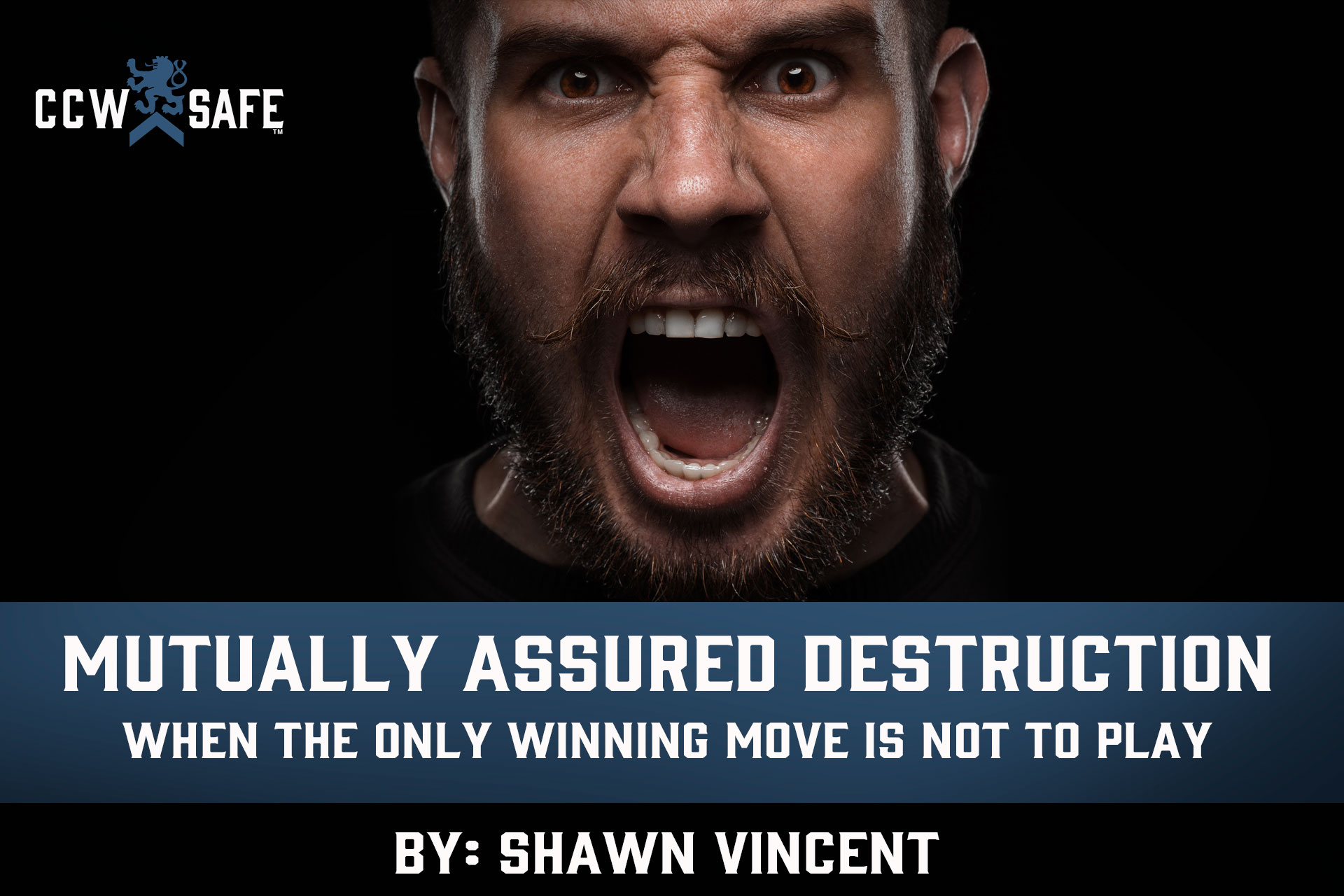
Posted on October 25, 2019
Mutually Assured Destruction
Mutually Assured Destruction
When the only winning move is not to play
Self-defense lawyer and CCW Safe contributor Andrew Branca recently wrote about an interesting brandishing case out of Tennessee where an off-duty EMT named Jimmy Robinson Jr. chased down some teen-aged “ring-and-run” pranksters who had just struck his home. Robinson took his pistol, and when he encountered the culprits, he ordered the teens out of their vehicle at gunpoint. When police arrived, they arrested Robinson; he’s been charged with two counts of aggravated assault.
The assault charge might be the best thing that could have happened to Robinson in this circumstance. What if one of the teens had been armed? That kid would have been reasonably in fear of imminent death at the hands of Robinson, and using deadly force may have been justified. By drawing his pistol, Robinson risked a shootout where he would have been the first aggressor. He’s lucky he’s not dead or facing murder charges.
All that said, does anyone really believe Robinson was out to kill those kids? I don’t think so. It’s much more likely that he was angry and wanted to scare them. If you believe that, then you can believe that not every assailant who presents a weapon has the intent to kill.
We’ve written about an off-duty firefighter from rural Indiana named Dean Keller who got into a shootout with his neighbor, Jeffrey Weigle. The neighbors had been at odds for years, and once had a fight that resulted in a stabbing and bite wounds. On June 27, 2017, a security camera captured footage of the two exchanging obscenities in their backyards, shouting over the fence they shared in common. After insulting Keller’s wife, Weigle, atop a riding lawnmower, briefly exits the frame. When he returns, he pulls out a revolver and points it in the air. Keller responds by unholstering his pistol and firing multiple shots, striking his neighbor four times.
According to reporting from the IndyStar, Johnson County Prosecutor Brad Cooper declined to charge Keller in the shooting. “Given the aggression shown by Weigle,” Cooper said, “it was reasonable for Keller to believe deadly force was necessary to prevent serious bodily injury to himself (and) his wife.” That’s legally true, and no one can blame Keller for responding to the threat (and few would argue that Weigle didn’t have it coming). But if we look back to the Robinson case from Tennessee, we’ve got to ask whether Weigle really intended to murder Keller and his wife or if he was just trying to scare them. Either way, Weigle discovered that if you draw on a concealed carrier, you’re probably going to be shot.
That’s what happened to 22-year-old Andre Sinclair in Davie, Florida. Keith Byrne, while driving his utility truck, inadvertently cut Sinclair off in traffic. Sinclair became enraged, and at a stoplight, he exited his vehicle with a pistol and approached Byrne. Sinclair, no doubt, had no idea that Byrne was a Marine veteran and a concealed carrier. Confronted with an aggressive armed assailant, Byrne did what you’d expect; he drew his pistol and fired. Both men were struck in the ensuing gunfight. Byrne died in his truck. Sinclair died later in the hospital. Like in the case of Weigle and Robinson, we have to wonder whether Sinclair really meant to murder Byrne, or whether he was just being a tough guy. It doesn’t matter because the law didn’t require Byrne to wait around and find out, which made the ensuing shootout inevitable. It was mutually assured destruction.
There’s a couple lessons here for concealed carriers.
First, don’t be a Robinson or a Weigle or a Sinclair. Never introduce your firearm to a non-lethal situation. At best you’ll be guilty of a felony, and at worst you’ll be dead like Sinclair.
The second lesson is more complicated because, while we can argue that the aggressor in these cases most probably didn’t intend to fire, what’s a concealed carrier to do when threatened with a deadly weapon? I spoke to CCW Safe National Trial Counsel Don West about these scenarios and he likened them to two men standing in a puddle of gasoline, each holding a lit match. The explosive result is practically guaranteed.
Keep that in mind when you carry. We’ve seen here three examples where relatively minor insults escalated into life and death situations in mere seconds. If Keller had refused to exchange insults with his neighbor, or if he had chosen to go inside and wait for Weigle to leave, he wouldn’t have been caught on the runaway train of events that led inevitably to the shooting. Had Byrne sped away when he saw Sinclair exit the car, he could have avoided the deadly shootout.
I recently watched the 1980’s film War Games with my kids. A military supercomputer runs a series of simulations while playing a game called Global Thermonuclear War. It learns that every engagement leads to a no-win scenario. The computer concludes, “The only winning move is not to play.”
It sounds weird to suggest running away from these situations. It feels cowardly. However, if you understand how quickly a shouting match can turn into a shooting match, then as a concealed carrier, you know walking away from a verbal spat is the responsible thing to do. As a concealed carrier, the only way to win a heated verbal conflict is to walk away. Think of it as saving the other person’s life — and possibly your own.
 |
SHAWN VINCENT- LITIGATION CONSULTANTShawn Vincent is a litigation consultant who helps select juries in self-defense cases, and he manages public interest of high-profile legal matters. If you have any questions for Shawn, or would like more articles like this, let us know belo |